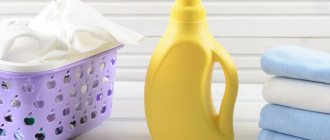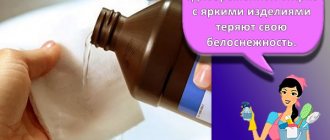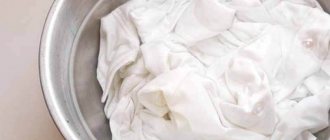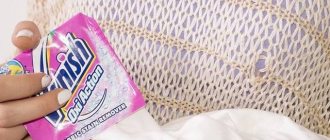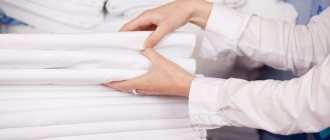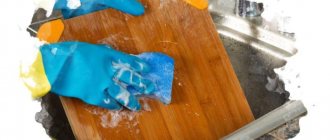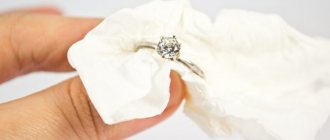No matter how carefully you treat white things, the influence of various factors can lead to the appearance of stains, yellowness and grayness. Regular washing of clothes cannot be done here; you need to resort to bleaching them.
As a bleach, you can use special household detergents or proven folk remedies.
Traditional method - boiling
Our grandmothers used it when there were no automatic washing machines. Only cotton and linen fabrics are allowed to boil. It is advisable not to use this method for clothing.
We recommend bleaching the following items using boiling water:
- bed sheets;
- kitchen and bath towels;
- tablecloths;
- panties, bras;
- socks;
- baby rompers and diapers.
Only dishes with an enamel coating or stainless steel are suitable for bleaching. After boiling in galvanized aluminum buckets, reddish-brown stains may remain on the white.
For 1 kilogram of things take 10 liters of water. The procedure is as follows:
- Dissolve half a piece of laundry soap and 2 tablespoons of baking soda in a bowl of warm water. Soak white items for 3 hours.
- Remove the laundry and rinse thoroughly in clean water.
- Pour cold water into a large container and place the items that need to be bleached at the bottom. You can add a little ammonia or hydrogen peroxide, soap shavings.
- Turn on the burner.
- Bring the solution to a boil and then turn the heat to low. Boil things for 1-1.5 hours.
- Cool and rinse the laundry thoroughly.
A common mistake made by housewives is immersing white clothes in boiling water rather than cold. This causes the yellow stains to become “sealed” onto clothing and bedding.
How to whiten white things at home - folk remedies
Whitening products depend on the item you want to restore its whiteness. Particular attention should be paid to:
- Lace and regular underwear. You need to wash yellowish underwear by hand and in warm water so as not to damage the thin fabric. The best whitening agent is hydrogen peroxide. You cannot boil the product; the fibers will lose their structure and you will simply throw away the laundry.
- Items that were accidentally dyed during general washing. Antilin detergent will help whiten items made of synthetic fabric; for natural materials, you can use boiling in a solution of water and hydrogen peroxide (dissolve 2 tablespoons of peroxide in 5 liters of water, boil the item for 30 minutes).
- Clothes made from polyester. Most modern things are made from synthetic fabric, so it’s worth remembering that:
- it cannot be bleached at high temperatures;
- Do not use products containing chlorine;
- Dry after bleaching in a washing machine.
- Bleaching things with colored prints is the most difficult case for a housewife. It is impossible to completely soak things. Therefore, apply any of the available stain removers or ordinary laundry soap to the contaminated areas, and leave to soak for a couple of hours. Then carefully wash the item.
For all other things in your wardrobe, such as white T-shirts, trousers, blouses, use folk remedies that our grandmothers used.
Hydrogen peroxide and soda
Using a mixture based on three percent hydrogen peroxide and soda will get rid of stains and yellowness. Dissolve 200 milliliters of three percent peroxide and 50 grams of baking soda in 5 liters of warm water. Place clothes in the solution and soak for 12 hours. Then wash with laundry soap.
Aspirin
Every medicine cabinet contains aspirin. It will save you not only from headaches and fever, but also from yellowed things. Carrying out the whitening procedure: dissolve 7 tablets of aspirin crushed into powder in 5 liters of warm water (50°C). Dip white items into the resulting solution and leave for 10 hours. After soaking, wash in soapy water.
Lemon acid
Using citric acid will whiten clothes from yellowness, and also give them freshness and softness. Acid cleaning involves soaking items in a soapy acid solution for a couple of hours. The mixture is prepared using 5 liters of water (50°C), 20 grams of powder, 20 grams of citric acid. After soaking, wash the product in the machine, selecting the normal washing cycle.
Sunflower oil
It's hard to believe, but you can remove yellowness from white things with the help of sunflower oil. It is recommended to bleach waffle kitchen towels. Boil five liters of water. Pour 10 milliliters of vegetable oil into boiling water, add 10 grams of bleach, 50 grams of washing powder. Mix all components until completely combined. Dip dirty clothes into the resulting solution and leave for three hours. Then wash by hand or machine. If the stains are not removed, repeat the procedure.
Soda and vinegar
A mixture based on soda and vinegar will allow you to remove stubborn stains from wine, juice, and sauce on white things. Cover the area of contamination tightly with a layer of baking soda, followed by 9% vinegar. To remove the stain faster, scrub it with a brush or sponge, moving in one direction. Leave the product in this state for several hours, then wash and dry in the sun.
Important! You cannot use baking soda and vinegar to remove stains on silk, wool or dyed fabric.
Trusted salt
Regular table salt will help save things from yellowing. Sodium chlorine is used in bleaching both synthetic and natural fabrics. Prepare a soaking solution based on 100 grams of salt and a liter of water at a temperature of 50°C. Soak the fabric item for an hour, then wash it with laundry soap. The yellowness should disappear.
Potassium permanganate and laundry soap
Potassium permanganate crystals and laundry soap together are a good bleach for clothes. Wash whites or linens. Then grate a bar of laundry soap and add it to a ten-liter bucket of boiling water. At the same time, prepare a liter jar of a one percent solution based on potassium permanganate. Pour potassium permanganate into the soap solution and stir. Dip things into the resulting solution and leave for six hours, covering the bucket with a lid so that the water maintains its temperature longer. When the solution has cooled completely, rinse your clothes or linen and wash them in a machine.
Mustard
Mustard powder will save your kitchen towels and napkins from yellowing. Mustard has disinfectant properties and removes greasy stains. Dissolve five tablespoons of mustard powder in five liters of boiling water. Leave the resulting mixture to sit for three hours. Strain the solution through cheesecloth. Place the items in a basin and fill with the strained mustard mixture. If the stains are minor, soak for 20-30 minutes. Then wash the fabric items in a soapy solution made from laundry soap, rinse and dry.
Soda and laundry soap
Baking soda and laundry soap will help get rid of yellowness or grayness on things made from natural fabrics. Heat five liters of water to 40°C. Dissolve half a glass of soda and 50 grams of laundry soap in it, after grating it. Bring the solution to a homogeneous consistency and heat it again to 40°C. Dip the items into the resulting mixture and leave them to soak for 5 hours. Then wash in the washing machine.
How to bleach laundry without boiling at home?
It is worth resorting to boiling laundry only when there are strong and old stains. This method is not suitable for frequent bleaching, as it leads to thinning and destruction of tissue.
Luckily, the store sells commercial bleaches in liquid and powder forms. Some are suitable for hand washing clothes in warm or cold water, others are suitable for automatic washing.
There are many home remedies that allow you to restore the whiteness of white things without boiling: soda, salt, ammonia, aspirin and others.
Professional products
If the natural options do not suit you, then doctors can effectively whiten problem skin using iontophoresis. This is a little expensive (in Cheboksary up to 500 rubles per session, and in Moscow - up to 700), but there is a guarantee for a long-lasting effect. Validity period is about a month. Ask cosmetologists in your city how much this procedure costs in their salon. When rinsing off, avoid intense friction; it is better to wet the clay with a washcloth, and then carefully remove the remaining mask.
Often pigment spots are removed using laser peeling, but here a lot depends on the reason for their appearance. Similarly, you can use chemical peeling with fruit acids.
Professional cosmetics will also help you whiten your face. Brands Mary Kay, CS2, Negru produce entire lines for lightening the epidermis. But, of course, the required action can be carried out in the shortest possible time only if an integrated approach is used.
The best way to whiten
There is no universal product that is suitable for bleaching all types of fabrics and items and removing all types of stains. The best method is the one that is selected for a specific case.
To make it easier for you to navigate whitening products, we suggest that you familiarize yourself with the table:
| Way | What fabrics is it suitable for? | What does it cope with? |
| Hydrogen peroxide | Cotton, wool | Returns whiteness to gray and yellowed items, removes traces of sweat, grease, and cosmetics |
| Aspirin | Linen, wool, synthetics, cotton | Fresh blood and sweat stains, gray coating |
| Aspirin | Cotton, synthetic | Fresh blood and sweat stains, gray coating |
| Salt | Cotton, synthetic | Cotton, synthetic |
| Potassium permangantsovka | Any | Removes traces of sweat, deodorant, and restores brightness to prints on white items |
| Mustard powder | Anything except silk | Gray coating, traces of fat, yellow spots |
| Citric acid, lemon juice | Cotton | Light soiling on clothing: yellow residue in the armpits and back |
| Chlorine bleaches: “Whiteness”, “Snow White” | Cotton, linen | Gray, yellow marks, blood |
| Oxygen-containing bleaches: “Soap nuts ECO 2”, “Persol Extra”, Oxygen | Any | Old yellow stains, fading of fabric, traces of grease, blood, red alcoholic drinks |
| Optical brighteners: Vanisn Gold, Heitmann | Cotton (you cannot wash clothes and baby items, as bleach particles remain in the fabrics), synthetics | Masks grayness and yellowness |
We recommend: How to wash holofiber pillows using a washing machine and not spoil the products?
Now let’s look at each whitening method in more detail.
Removing yellow sweat stains
Unpleasant stains like sweat stains are difficult to remove. These stains are organic and difficult to remove, as they eat deep into the fiber structure of the fabric. Such stains can be completely removed only with aggressive chemicals, but there is a risk of damaging the fabric itself.
All that remains is to wash white items after each wear, especially in summer and winter.
If yellow spots appear in the armpit area, you can use:
- Chlorine – for linen and cotton items. Baking soda can also be used, but the effect will be less.
- Mustard powder, peroxide and ammonia - in the case of silk and wool.
- Table salt - in relation to synthetics. In order not to damage synthetic items, you will have to use only salt, of course it will take more time, but you can safely bleach this fabric.
- Soaking is a must for any fabric.
Before bleaching any item, first test your product on a small area of fabric to see the results. This way you will avoid many problems later.
How to bleach things with soda and hydrogen peroxide?
At home, it is better to start whitening with folk remedies that every housewife has in her kitchen. They are safe for health and do not require large financial investments.
How to use baking soda?
- Fill a 10-liter bucket halfway with warm water and add 6 tablespoons of baking soda. Pour in a spoonful of ammonia and stir.
- Place clothes (bed linen) at the bottom of the bucket. Leave to soak for 2-5 hours depending on the degree of contamination.
- Rinse white items thoroughly and machine wash them at 60 degrees.
If the contamination is significant, use a 3% solution of hydrogen peroxide, which is sold in any pharmacy:
- Pour a tablespoon of solution into a 3-liter bowl of water.
- Soak white items for 30-60 minutes.
- Rinse thoroughly and dry. If the weather is sunny, hang your laundry outside.
Using hydrogen peroxide, you can remove individual stains on cotton. To do this, treat the yellow area with the solution and wait 5 minutes. Gently scrub the fabric with a bar of soap and rinse with water.
How to prevent re-staining?
White items change their original color due to non-compliance with washing rules. To avoid this problem again after the whitening procedure, you need to adhere to several rules:
- Do not wash white and colored linen together;
- do not wash old and new items together - even if a recently purchased item has a small colored insert, it may fade;
- rinse the laundry thoroughly after washing;
- Do not dry things on heating devices or in the sun. Because of this, they may turn yellow.
If it is impossible to avoid washing white and black items together, then you need to use color-catching napkins (Chameleon, Dr. Beckmann and others). Their average cost is 300 rubles.
You can learn how to prevent shedding and save faded white things from this article.
Using aspirin to lighten tissue
A white T-shirt (shirt) has a gray tint due to frequent washing, but you don’t want to ruin your favorite item by bleaching it? Choose gentle methods, which include aspirin. The active ingredient is acetylsalicylic acid. It penetrates deep into the tissue, removes residual powders and concentrates.
How to use aspirin for whitening?
- Crush 5 tablets into powder. Dissolve in two liters of hot water.
- Soak a white T-shirt or shirt in the solution overnight.
- In the morning, wash the item by hand with regular soap or put it in a washing machine. You can add 2-3 more aspirin tablets to the washing powder. By the way, this method is suitable for preventing fabric tarnishing.
- Shake and leave the item to dry.
Causes of bad complexion
The skin of the inhabitants of central and northern Europe is naturally white and easily burns in the sun. As soon as you lie on the beach a little longer or forget to apply protective cream against UV rays, it turns red and after a couple of days begins to peel off. As a result, the tan does not apply evenly. Finding yourself in such situations from year to year can provoke the appearance of age spots, especially unwanted ones on the face.
Red-haired girls with thin, light skin develop freckles when exposed to sunlight, even in winter. It is important for them to use a protective lotion or cream on a clear winter day in the city and at ski resorts. If freckles still bother you and spoil your mood, a whitening mask will be a wonderful solution.
Hormonal imbalance is a common cause of pigmentation in young women. If this is the problem, then cosmetics will help little. A visit to the doctor and prescribed treatment will restore health to the body, after which the skin color will quickly restore.
The cheapest way is salt
Most often, salt is used to prevent yellowing of bed linen and kitchen towels: once a month, before washing, white items are soaked for 2 hours in a solution of warm water with the addition of 2-3 tablespoons of salt.
If you need to bleach grayed items, salt is used in combination with hydrogen peroxide, baking soda, ammonia or boric acid. Sodium chloride enhances the effect of these bleaches.
The procedure is as follows:
- Add 3 tablespoons of salt and hydrogen peroxide, a teaspoon of ammonia and a little washing powder to a bowl of hot water.
- Place items in a basin for 2 hours and then wash.
- Rinse and leave to dry.
Whitening things with sunflower oil
- Pour water into an enamel bucket and boil .
- Pour in two or three tablespoons of vegetable oil, about a glass of washing powder, and a quarter glass of bleach.
- Mix everything well and place the laundry there for a long time, cover with a lid. It's better to start this business at night.
- The washing process is already underway. Vegetable oil helps chemical detergents penetrate fabric fibers better.
- After ten hours (or longer), wash and rinse the laundry.
Delicate whitening – potassium permanganate
Use this method if you want to return sparkling whiteness to silk blouses and dresses. Potassium permanganate acts gently and does not destroy delicate tissue. True, it will not help get rid of old stains.
- Prepare a solution of 10 liters of water, half of baby soap and 4 crystals of potassium permanganate.
- Soak the item for 6-8 hours.
- Rinse and dry.
Whitening hands and feet
If achieving aristocratic whiteness on the face is not as difficult as it seems, then whitening inflamed skin on the elbows, knees, or even more so, heels, is very difficult. We need to act more comprehensively and more harshly.
- Make a paste by mixing mashed banana, warm liquid flower honey, lemon juice and margarine. Apply the mixture and cover them with a breathable natural fabric bandage, say cotton, bandage or gauze. When using on the palms and feet, you can wear cotton work gloves or socks. In the morning, remove the compress, remove the remaining mass with a paper napkin.
- Korean women often use cabbage decoction to whiten their heels after wearing leather shoes. According to reviews, the active elements of this vegetable have a very positive effect on rough skin. The layer of dead cells is removed, the upper part of the epidermis is softened. You will need from 5 to 10 leaves per liter of water, steam for about 20 minutes. You can repeat every day, if desired, add citrus juice to the solution, which contains acid that can whiten any rough areas.
- Blackened skin on your knees can be quickly whitened and exfoliated by rubbing mango and potato puree over the area. Potatoes contain starch, which is known for its bleaching and astringent properties. Grind one fruit and half a vegetable, mix, if desired, you can add a spoonful of milk. Apply a thick layer overnight and leave until morning.
- To remove chafed, brown skin on your heels, elbows, or palms, mix two tablespoons of sugar, lemon juice, and olive oil. The result will be an oily abrasive mixture. Rub intensively over problem areas, then leave the mixture for another 20 minutes.
Photo - Hand whitening before and after
Use of mustard powder
Mustard is the best home remedy for removing grease stains from white clothes. Housewives use mustard powder to care for cotton tablecloths, towels, and kitchen curtains.
The procedure is as follows:
- Dissolve a bag of mustard powder in 5 liters of hot water.
- Leave things in the solution for 3 hours.
- Rinse with clean water to remove any traces of mustard and place in the washing machine.
- Dry white items.
Handwash
The algorithm is as follows:
- If the items have turned yellow, soak them in soapy water before washing. To enhance the effect, use ammonia - 1 tbsp is enough. l. for 5 liters of water.
Important! It is convenient to bleach things in ammonia because it has a softening effect on water and also binds magnesium salts. They are the source of unattractive yellowness on things.
- Laundry soap also does an excellent job of removing gray stains on white fabrics. Lather the product and place it in a plastic bag. Tie it so as not to let air in and leave it for about a day. During subsequent washing, add ammonia in the same proportion.
Citric acid and lemon juice
These products perfectly remove gray and yellow plaque, but are harsh, so they are only suitable for cotton fabrics. Also, using citric acid, remove stains on shoes: sneakers, textile ballet shoes.
- Dissolve 10 tablespoons of citric acid or juice from two citrus fruits in a 10-liter bucket of hot water.
- Soak white items for 5-6 hours.
- Rinse and leave to dry.
We recommend: What is the easiest way to wash a large soft toy?
Return of white flowers to faded textiles
Before bleaching a faded white item, you need to remember that the work must be done promptly. You can restore color if you begin resuscitation procedures immediately. The first remedy is repeated washing with the addition of a double portion of white laundry detergent fortified with soda ash (at a ratio of ten to one). If this method does not help or damage is discovered over time, there are more radical methods:
- cotton items can be boiled with peroxide and ammonia solution. For a ten-liter bucket of water you need a glass of hydrogen solution and 15 milliliters of ammonia, boiling time is half an hour;
- You can try to revive linen, denim, thick cotton with a special paste. The water-soda mixture is applied locally for about 20 minutes, then the textiles are sent for washing;
- Synthetics can be saved with soapy water. A crushed piece of laundry soap is mixed in half a liter of water, strengthened with two tablespoons of peroxide and five ammonia. The mixture is dissolved in a bucket of water, where faded synthetics are soaked for up to half an hour before washing.
Note! No prescription is guaranteed to work. The item may not be washed to its original whiteness, then the only way is to repaint the clothes a different color using ready-made dyes.
We recommend:
How to remove glue from glass
Chlorine bleaches
In the past, our mothers and grandmothers often used the industrial chlorine product “Belizna” for bleaching. And now it can be found on sale in liquid or powder form. It costs mere pennies, but it perfectly removes grayish plaque and any old stains, including those from sweat, grease, blood, wine, and grass.
But “Whiteness” also has a number of significant shortcomings.
- not suitable for wool, delicate fabrics, synthetics, white items with bright patterns;
- with frequent use it leads to thinning of the fabric, the formation of holes, abrasions, and yellow stains;
- causes allergic skin reactions in some people;
- It smells bad;
- Chlorine vapors are unsafe for the respiratory system and irritate the mucous membranes of the eyes.
Use chlorine bleach only with rubber gloves. You should try not to inhale the smell, and after treating white things, ventilate the apartment.
How to whiten white things using “Whiteness”?
- Soak the laundry in water and soap (half a piece) for 2 hours.
- Wash by hand.
- Pour cold water into a 3-liter basin. Add a tablespoon of bleach.
- Pour the resulting liquid into a container with white things. Leave for 15-20 minutes.
- Rinse and dry the laundry thoroughly.
Chlorine reacts with metals and can damage your washing machine. Although some manufacturers leave the “Automatic” mark on product packaging, it’s not worth the risk. Wash white items with “White” by hand.
Fabric bleach at home - ready-made products
Using ready-made bleaching products will reduce your time preparing traditional methods. You can achieve dazzling whiteness by:
- stain remover "Sarma Active 5 in 1". Fights both stubborn stains and fresh ones;
- stain remover "Vanish OXI Action". Perfectly fights against fresh stains, gives white things whiteness;
- Amway PreWash Spray stain remover. Removes fresh stains on white, but does not cope well with yellowness;
- stain remover pencil “Faberlic (Edelstar)”. Removes stains point by point; there is no need to completely wash the item in soapy water;
- powder "Eared Nyan". Will cope with any dirt, but will not give dazzling whiteness;
- Beau Plus Maximum bleach. Budget powder with whitening effect. Removes stains of various natures and adds whiteness.
Instructions for using ready-made products are written on the packaging.
Whitening clothes at home is the best way
Among the many effective ways to whiten clothes, the best method among housewives is considered to be boiling, with the addition of peroxide and ammonia. For the cleaning process you will need:
- ten-liter saucepan;
- 9 liters of water;
- 50 milliliters of hydrogen peroxide (3%);
- 20 milliliters of ammonia.
Heavily washed and yellowed laundry can be bleached as follows. Place the bedding in boiling water. Boil for 30 minutes. Add half a bottle of three percent peroxide and ammonia directly to the bubbling water. The product must be constantly covered with the solution, so as the water evaporates, you need to add it. After boiling, allow the laundry to cool. Hand wash and rinse. Dry naturally.
Oxygen-containing bleaches
The main advantage of such products is delicate whitening. With their help, grayness is removed even from silk blouses and dresses. Oxygen-containing bleaches disinfect fabrics and remove unpleasant odors.
The substances are easy to rinse out, so people do not experience allergic skin irritations later. Suitable for whitening children's clothes.
But oxygen-containing bleaches also have two disadvantages: high consumption and high cost.
Cosmetics for skin lightening
An effective modern procedure is to use a laser to whiten facial skin. Many aesthetic medicine clinics or online beauty salons have special devices for resurfacing the skin or carefully removing its rough top layer. Getting rid of dead cells allows you to even out your skin tone and achieve noticeable lightening.
You should be careful with tablets and creams imported from China and Thailand. Local girls have had a cult of white skin for centuries, and nowadays manufacturers of cosmetic products actively take advantage of this.
Many creams contain mercury, which is poisonous to humans. Its permissible limit is exceeded thousands of times compared to its European and American counterparts. Of course, mercury gives a quick lightening effect, but when it accumulates in the skin, it poisons the body. The composition of the tablets with instructions written in hieroglyphs is a complete mystery that it is better not to try on yourself.
In beauty salons you can make a peeling or mask based on patented foreign cosmetics, but a whole course is needed to achieve the goal. Salon treatments are not cheap, so it is better to take care of your skin at home by choosing a suitable cream or mask made from natural ingredients.
Optical brighteners
They are quite expensive. After washing with optical brightener, clothes acquire a crystal clear appearance. But this impression is deceptive.
The fact is that optical brighteners contain fluorescent substances that cannot be completely rinsed out and remain on the fabric. Once dry, the particles reflect light, and bedding and clothing emit a white glow. Unfortunately, fluorescent substances can cause allergies upon contact with skin.
It is recommended to use optical brighteners when you urgently need to give things a snow-white appearance.
Clothes have faded
You followed all the rules, but your white clothes faded when washed. What to do? The main thing in such a situation is to quickly take the necessary measures. In fact, things can fade not only because of washing with colored items. It happens that a forgotten piece of paper in your pocket - a candy wrapper, a wrapper, a note - will stain your white things. In this case, you cannot do without strong bleaches.
It’s good that nowadays there is a huge selection of different brands of bleaches. But they are all divided into two types: oxygen-containing and chlorine-containing.
It is believed that chlorine has a more effective effect in terms of bleaching things, but only in the case of natural fabrics. The advantage of such bleaches is their disinfectant properties. Chlorine is excellent at killing germs and bacteria, so your items undergo additional treatment. For items made of silk and synthetics, it is advisable to use a permissible amount of chlorine-based bleach so as not to damage the fabric.
Oxygen-containing bleaches act by a chemical reaction. Oxygen crystals, when oxidized during washing, push organic substances out of the fabric of white items, while being gentle on the fibers of the fabric itself. Unlike chlorine-based products, oxygen bleaches can be used in washing machines. The effect of oxygen is much less than that of chlorine, but this product is more gentle on delicate fabrics.
Let's take a closer look at the example of two of the most famous representatives of household chemicals for whitening things.
- A representative of chlorine bleach is Whiteness.
Suitable not only for restoring faded items, but also for treating a room. The advantages are an affordable price and disinfectant properties. The downside is the strong chemical effect on the fabric. After frequent washing with white, the fibers become thinner and break.
It is forbidden to use Whiteness for silk and woolen items!
Another disadvantage of this product is that it cannot be used in a washing machine. Chlorine can damage parts and cause failure.
It should be remembered that chlorine is a chemical element that tends to evaporate. When using it, follow the rules and safety precautions to avoid burns and allergic reactions. Ventilate the room in which you wash and put on rubber gloves.
- A representative of oxygen-containing bleaches is Persol.
The advantage of this product is that it is suitable for any type of fabric due to its soft action. The oxygen contained in the composition, when exposed to contamination, does not spoil the fibers themselves. The characteristics of the bleach indicate that it can be used at any temperature. That is, it becomes possible to restore faded items even in cold water. Persalt can be used in washing machines and does not contain harsh chemicals that can cause allergies.
Under no circumstances should you experiment and mix two different bleaches to enhance the effect! This will definitely ruin your things.
Oxygen bleaches can also be used when washing children's clothes.
Now you know that white items that have not been washed correctly can be restored, but only with the use of professional products. But how to restore gray fabric?
Prevention of gray plaque and yellow spots
Unfortunately, frequent bleaching causes fabrics to become fragile and thin. In the end, the item cannot withstand exposure to aggressive substances and deteriorates.
And sometimes clothes are so hopelessly damaged that it is no longer possible to bleach them. Therefore, it is important to regularly care for your things and follow the rules of washing and drying.
We suggest you familiarize yourself with a few tips:
- Place white clothes in the machine immediately; do not wait until the basket is filled to the brim with dirty laundry.
- Wash colored and white clothing items separately.
- Once a month, add salt, baking soda or powdered oxygenated bleach to the machine before washing.
- Rinse your laundry thoroughly: residues of powders and concentrates lead to the formation of a gray coating on clothes.
- Do not wash cotton and linen at the same time as wool or synthetics.
- Do not mix clothes with other things: bed linen, kitchen towels, panties and socks.
- Follow the temperature range indicated on the label.
- If possible, dry clothes in the sun.
- Do not put damp wardrobe items in the closet, otherwise they will become dull.
How to bleach fabric
If desired, you can discolor the material. Any chlorine bleach can remove dye from fabric. To do this, it is diluted in water. The exact proportions are indicated in the instructions for the specific product. Place the item of clothing completely in the container with the solution. Boil for 1 – 2 hours (until the color disappears).
In addition, you can bleach clothes using the following substances:
- hydrogen peroxide;
- soda;
- lemon acid.
It is better to dry white clothes in the sun: this preserves their brightness.
For whitening, you can use both professional and home remedies. It is necessary to follow the recommendations so as not to damage the fabric. Also, do not forget that with frequent use of bleach, clothes can lose their attractive appearance.
The cost of homemade formulations is several times less than ready-made ones. The ingredients are easy to buy in grocery stores and pharmacies, easy to store, and easy to mix.
Useful tips
A clay mask perfectly helps to nourish the skin and remove dead cells. After dissolving the powder purchased at the pharmacy with warm water and applying the resulting paste to your face and neck, you should let it dry. After washing off the layer of clay, the skin will become smooth and silky, and the complexion will be more fresh.
The mask is well suited for girls going on vacation to the sea. After it, the tan will lie evenly, but you still shouldn’t neglect protective equipment.
Particular attention should be paid to the quality of cosmetics and creams. If you experience even a mild allergic reaction or unpleasant tingling sensation during use, you will have to discard this product. The skin of the face is very delicate and should be as comfortable as possible.
The cause of pigmentation can be metabolic and hormonal imbalance in the body. Pregnancy and childbirth, taking certain medications and even severe stress contribute to the appearance of brown spots on the skin. Sometimes they disappear on their own after the body’s condition normalizes, but more often they have to be countered using the above methods.
